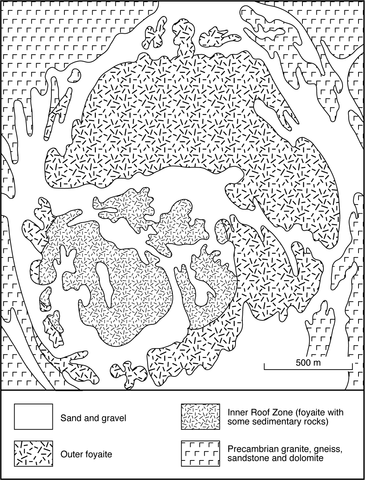stripes
This complex is intruded into Precambrian feldspathic sandstones, dolomites and argillaceous rocks and underlying granite gneisses all of which are strongly metasomatised along the contacts. The intrusion is divided by Marsh (1975a) into an Outer Foyaite zone which forms a broad, but assymetric, outer ring, and an Inner Roof zone which preserves remnants of the sedimentary roof, various layered rocks, and a plug of foyaite - the Inner Foyaite. These two units were preceded by emplacement of sheet-like intrusions of nepheline syenite porphyry and followed tinguaite and quartz bostonite dykes. The early porphyritic syenite forms sheets to the northwest and southwest of the main complex. The phenocrysts are euhedral perthites set in an altered matrix and including pseudomorphs after rare mafic and nepheline phenocrysts. The Roof Zone is complex, and for structural detail the reader is referred to the sections and description of Marsh (1975a). Overlying sediments are preserved in places and consist of fenitized thin bedded phyllites and feldspathic sandstones and some dolomite which, according to Marsh (1975a), is sedimentary and not carbonatitic (see Verwoerd, 1967, p. 244). Beneath the sedimentary rocks are chilled nepheline syenites that grade downwards into coarse-grained nepheline syenite. These rocks contain phenocrysts of perthite, nepheline, rare salitic pyroxene and biotite in a matrix of the same minerals with titanite, Ti-magnetite and apatite. A cylindrical intrusion of foyaite, the Inner Foyaite, overlain by a layered sequence, is the largest unit of the Roof Zone. The upper part of the layered sequence is a xenolith-rich foyaite which is in contact with the chilled zone. The xenoliths stoped from the roof are abundant in the upper half of the sequence but decrease in abundance downwards until a xenolith cumulate zone is reached. Beneath this is a layered foyaite unit which is characterised by igneous lamination and rhythmic mineral layering, the cumulate minerals being alkali feldspar and aegirine. This unit passes down into the Inner Foyaite. In parts of the intrusion this ideal sequence is disturbed and the igneous layering and lamination may have irregular dips up to 70°. The Inner Foyaite is a cylindrical, texturally concentrically zoned intrusion, the rock consisting of perthite, nepheline, biotite, aegirine-augite, rare sodic amphibole and accesssories including perovskite (?) and astrophyllite. The Outer Foyaite is a coarse rock of perthite, nepheline, zoned sodic pyroxene and minor sodalite. Marsh (1975a) was able to distinguish an agpaitic outer zone containing accessory aenigmatite, arfvedsonite, eudialyte-eucolite, lavenite and astrophyllite from an inner miaskitic zone with biotite, titanite and magnetite. Analyses of the aenigmatite and a discussion of this mineral and the co-existing astrophyllite will be found in Marsh (1975c). The Outer Foyaite has reacted extensively with sandstones at the contact to produce a suite of pulaskites, peralkaline nordmarkites and peralkaline granites, whereas assimilation of dolomite produced shonkinite, nepheline syenite and ijolite-melteigite, as described by Marsh (1975b). Tinguaites, which are the most abundant dykes in the vicinity of Granitberg and also cut both zones of the intrusion, comprise alkali feldspar, nepheline, aegirine and magnetite with accessory lavenite and eudialyte-eucolite. Bostonite and grorudite dykes are the last manifestations of igneous activity.
MARSH, J.S. 1975a. The Luderitz alkaline province, South West Africa I: Descriptive petrology of the Granitberg foyaite complex. Transactions of the Geological Society of South Africa, 78: 215-24.MARSH, J.S. 1975b. The Luderitz alkaline province, South West Africa II: Metasomatism and assimilation in the contact aureole of the Granitberg foyaite complex. Transactions of the Geological Society of South Africa, 78: 225-33.MARSH, J.S. 1975c. Aenigmatite stability in silica-undersaturated rocks. Contributions to Mineralogy and Petrology, 50: 135-44.Verwoerd, 1967.

